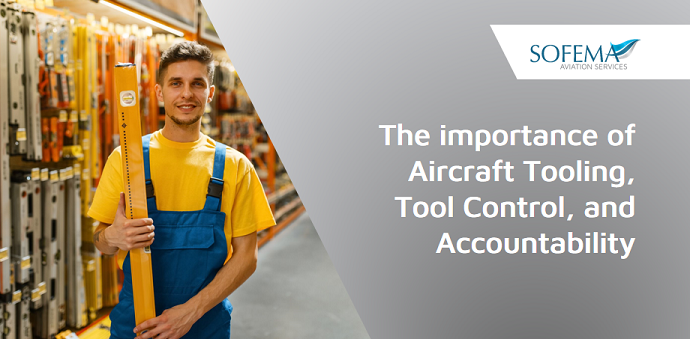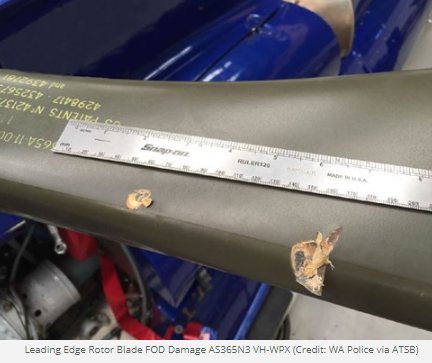Sofema Aviation Services (SAS) www.sassofia.com considers the importance of Aircraft Tooling, Tool Control, and Accountability.
Introduction – The Importance of Tool Control
We should all recognise that aviation is one of the safest and most secure forms of transport. However this is not “by chance” – It is the result of rigorous safety and maintenance checks that are carried out to ensure every aircraft which departs, does so safely.
With the challenge of ensuring both tool discipline & accountability, organizations face the need of being able to demonstrate all miscellaneous toolbox contents are under control for example the potential for – multiple sockets, spanners, screwdrivers etc. (How to know if one is missing)
Tools can become FOD – Rotor Blade Tool Control Incident
The Australian Transport Safety Bureau (ATSB) has just issued a report on an incident where a helicopter’s rotor blades were damaged during start-up by Foreign Object Debris (FOD), namely a tool that had been left behind from earlier maintenance.
The Incident Details
On 3 November 2015 Airbus Helicopters AS365N3 VH-WPX, operated by the Western Australia Police Air Wing, was undergoing maintenance check flights as part of the Rotor Track and Balance (RTB) task at Jandakot Airport, WA.
The Australian Transport Safety Bureau (ATSB) has just issued a report on an incident where a helicopter’s rotor blades were damaged during start-up by Foreign Object Debris (FOD), namely a tool that had been left behind from earlier maintenance.
A spanner that had been used during the third track and balance-related adjustments could not be located. (It was later located on an adjacent taxiway about 43 m from the hangar.)
Due to the scuff marks and scratches found on the spanner, it was determined that it had been left in the rotor head area and was likely ejected during the aircraft start-up.
Tools and Equipment Control & Management
Most Airlines have a fully developed Tool Control and Accountability Procedure typically driven by a requirement similar to the following requirement.
All tools and equipment that are required to be controlled in terms:
- Of servicing or
- Calibration
Should be identified and listed in a control register.
Note – This should also include any personal tools as well as equipment that the organization agrees can be used.
Tool Control Procedure
The control of such tools and equipment requires that the organization has a procedure to:
- Inspect / service and, where appropriate,
- Calibrate such items regularly and
- Indicate to users that the item is within any inspection or service or calibration time limit.
Tool Identification
A clear system of labelling all tooling, equipment, and test equipment is important and services as an effective way of indicating serviceability and providing information related to when the next inspection or service or calibration is due.
Unserviceable labels should be available for affixation if for any reason a tool is no longer available for use for any reason.
How Frequently to Inspect Tooling?
The Basic rule is to follow the manufactures guidance and instructions as a minimum. Based on operational experience the organisation may increase the depth or periodicity of any inspection requirement.
Mitigating the FOD Risk
With the challenge of ensuring both tool discipline & accountability, organizations face the need of being able to demonstrate all miscellaneous toolbox contents are under control for example the potential for – multiple sockets, spanners, screwdrivers etc. (How to know if one is missing)
Key to this is the fact that organizations need to be able to inspect and monitor the tools and equipment that are being used to service their planes. If a toolbox contains a random jumble of spanners, screwdrivers, and other tools, how can an airline possibly tell if one is missing?
Tool Control using Shadow Foam
Shadow Foam is a high-quality foam that can easily be cut and shaped. (The material comes in a variety of grades, meaning it can be customized according to your requirements for a cost-effective solution.)
The shapes of the tools are cut into the foam to create secure pockets for the items to sit in.
Next Steps
Please see www.sassofia.com and www.sofemaonline.com for Classroom, Webinar and Online Stores & Logistics, Regulatory and Vocational Training Courses.
For additional information please email team@sassofia.com or see the following 1-day training course covering the essential areas of the Part 145 Tooling Store:
Part 145 Stores Tooling Control, Inspection Procedures & Best Practice – 1 Day
Tags:
Aircraft Tooling, Australian Transport Safety Bureau, aviation, Aviation Tooling Store, EASA Part 145, EASA Part 145 Stores, FOD Risk, Foreign Object Debris (FOD), Part 145 Tooling Store, SAS blogs, Tooling Control





